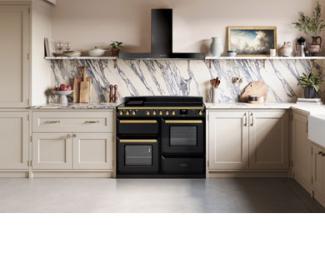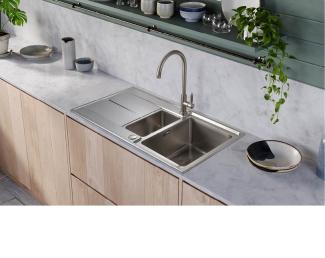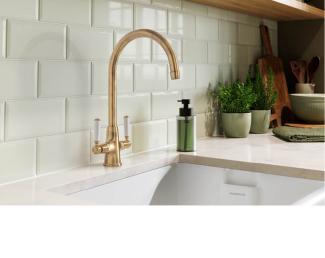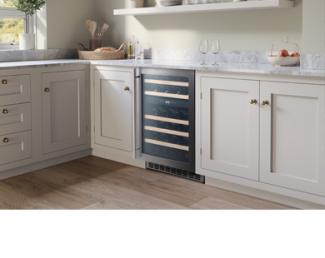There are many advantages of having a stainless steel sink in your kitchen or utility room, not least the ease of cleaning. In this handy guide on how to clean a stainless steel sink, we’ll give you some useful tips that will ensure this kitchen essential remains in good condition for many years to come.
In this guide, we’ll be covering:
- Why are stainless steel sinks a popular choice?
- The importance of keeping a stainless steel sink clean
- Stainless steel vs other types of sink
- Should I do a basic or deep clean?
- Cleaning methods
- How to remove tough stains and limescale
- How to get extra shine and sparkle
- Things to avoid
- FAQs
Why are stainless steel sinks a popular choice?
There are various reasons why stainless steel sinks are such a popular choice, including their durability, versatility and good looks.
As stainless steel is a strong and durable material that can resist dents, scratches and stains, it’s more than capable of withstanding heavy use, while maintaining its appearance over time. However, although your stainless steel sink will withstand a great deal of hard use, it can be scratched by hard or sharp objects.
Versatility is another advantage. With stainless steel sinks available in various shapes, sizes and configurations, they are suitable for a wide range of kitchen designs. Their sleek and modern look can easily blend into various kitchen styles, whether traditional or modern.
Of course, there’s also the fact that, because they are nonporous and resistant to stains and bacteria growth, it’s relatively easy to clean a stainless steel sink. And we’ll show exactly how best to do it.
The importance of keeping a stainless steel sink clean
A regular cleaning and maintenance routine is essential to keep your stainless steel sink working well and looking good. If you neglect to clean your sink regularly, it can become stained and discoloured, even developing an unpleasant odour. A dirty sink can also harbour harmful bacteria.
Stainless steel vs other types of sink
Choosing a stainless steel sink has some key advantages over sinks made from other materials, such as ceramic or granite. Stainless steel sinks are more durable, easier to maintain and resistant to stains and rust. They are also less likely to chip or crack, making them a practical and cost-effective choice for most homeowners.
Although stainless steel is still prone to unsightly water spots and fingerprints, they’ll no longer be a problem if you follow the advice in this guide on how to clean a stainless steel sink.
Should I do a basic or deep clean?
How often you need to clean a stainless steel sink obviously depends to a large extent on how often it’s used.
However, we would recommend a basic clean after each use, wiping the bowl and drainer with a soft damp soapy cloth and rinse with clean water. In hard water areas, you may also want to apply a cream or stainless steel sink cleaner to avoid a build-up of a dull film caused by waterborne deposits.
If your stainless steel sink is in daily use, a deep clean should be done at least once a week to remove any built-up grime, bacteria or stains.
Cleaning methods
There are several cleaning methods you can use to clean your stainless steel sink, including those which use items you probably already have in your home, such as baking soda.
Simply mix baking soda with water to create a paste and apply it to the sink with a soft-bristled brush. Scrub gently and rinse with water.
How to remove tough stains and limescale
To remove tough stains and limescale, create a solution of equal parts water and white vinegar or lemon juice. Apply the solution to the affected area with a microfibre cloth, let it sit for a few minutes and then rinse well with water.
How to get extra shine and sparkle
Stainless steel sinks can lose their shine over time, but this can be restored using olive or mineral oil for an eco-friendly cleaning solution.
After cleaning the sink, pour a small amount of olive or mineral oil onto a soft cloth or paper towel. Gently rub the oil onto the surface of the sink, covering it evenly.
Then, using a clean, dry microfiber cloth, buff the oil into the sink using a circular motion. The oil will fill any scratches and enhance the stainless steel's shine. Finally, wipe away any excess oil with a clean cloth.
Things to avoid
To keep stainless steel in the best possible condition and prolong its lifespan, there are certain things which shouldn’t come into contact with your sink.
- Coarse-grit scouring powders or soap-filled wire wool cleaning pad will mark the surface of the sink.
- Wire wool pads can leave tiny fragments of wire embedded in the surface which can rust and leave small brown stains.
- Always remove soap residue and wet cleaning aids, such as cloths and pads, from the sink surface after use to avoid the formation of water marks and discolouration.
- To prevent scratches, avoid placing heavy or sharp objects in the sink.
- Avoid using common domestic bleach as chlorine attacks the microscopic chromium oxide film on the sink’s surface and can cause pitting.
- Silver dip cleaners are particularly harmful since they contain strong acids that can cause discoloration and pitting.
- Acidic foodstuffs, such as fruit juices, damp salt, vinegar, ready-made mustards, pickles and mayonnaise can cause pitting and corrosion if left in contact with the stainless steel surface for long periods.
- We do not recommend the use of plastic washing up bowls as grit can attach to the base of the bowl which can scratch the surface of the sink.
FAQs
What is the best cleaner to use?
For daily cleaning, we’d recommend wiping the sink down with a soft cloth, perhaps using a mild detergent or washing-up liquid. Tougher stains can be tackled with baking soda, white vinegar or lemon juice using the methods described above.
What shouldn’t you use on stainless steel sinks for cleaning?
Avoid using abrasive cleaners, steel wool, bleach or harsh chemicals on stainless steel sinks. These cleaners can scratch or damage the sink's surface and cause discoloration.
How often should I be cleaning my stainless steel sink?
You should clean your stainless steel sink after each use to prevent water spots and discoloration. A deep clean should be done at least once a week to remove any built-up grime, bacteria or stains.
How do I clean a stainless steel sink without scratching it?
To clean a stainless steel sink without scratching it, use a soft-bristled brush, sponge or microfibre cloth.
How can I remove odours?
To remove odours from your stainless steel sink, mix white vinegar or lemon juice with water and apply it to the sink with a microfibre cloth. Let it sit for a few minutes and rinse with water. You can also sprinkle baking soda on the sink and let it sit for a few minutes before rinsing with water.
Can I use bleach to clean my stainless steel sink?
It's not recommended to use bleach to clean your stainless steel sink. Bleach can damage the sink's surface and cause discoloration.
In conclusion
A clean and well-maintained stainless steel sink not only looks better but plays an essential role in maintaining a hygienic environment in your kitchen.
By following the simple yet effective steps above, you can easily restore the shine and lustre to your stainless steel sink, while also preventing the build-up of stubborn stains and deposits. Remember, a little effort each day will go a long way in preserving the elegance and durability of your stainless steel sink for many years to come.











